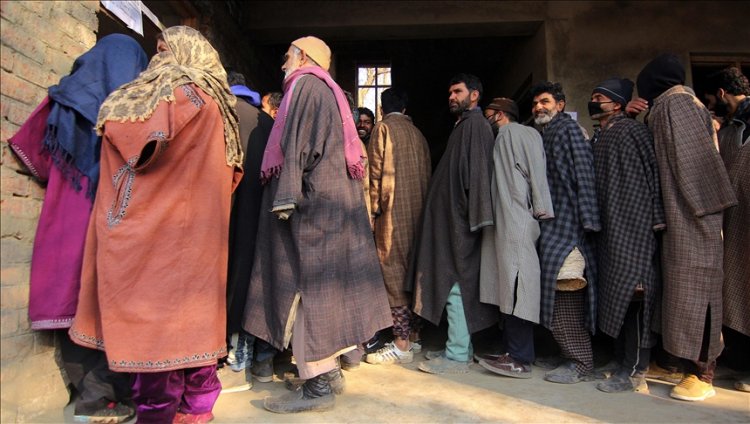Elections in Pak Controlled Kashmir
STORIES, ANALYSES, EXPERT VIEWS

Prime Minister (PM) Narendra Modi’s meeting with mainstream leaders of Jammu and Kashmir on June 24 brought renewed attention on the status of the Union Territories of Jammu and Kashmir (J&K) and Ladakh, with the fundamental issue at stake being Kashmir’s relationship with the Centre and the quantum of autonomy. As this process takes it course in India, Pakistan-administered Jammu and Kashmir goes to the polls on July 25. 2.88 million people are reportedly eligible voters.
Constitutional and practical realities
On the occasion, Luv Puri (author of Across the LoC) focusses on the constitutional and practical realities underpinning the electoral exercise highlighting some of the limitations of the popular global discourse around the Kashmir issue.
Pakistan refers to this area as “Azad (independent) Jammu and Kashmir”, meaning independent Jammu and Kashmir. Its legislative assembly, writes Puri “has the power to elect its prime minister and president. At international fora, the nomenclature of executive positions and a separate Constitution are presented as evidence by Pakistan that the region is an independent entity. However, the reality is a lot different. On top of this, the whole electoral exercise is held in a manner that perpetuates the unrealistic expectations and ideas that Pakistani society has about Jammu and Kashmir. This in turn has held all the efforts towards subcontinental cooperation hostage.
“First, there are contradictions between the Pakistani and PAJK (Pak Administered J&K) Constitutions. For instance….under Section 5(2)(vii) of the PAJK legislative assembly election ordinance of 1970, ‘a person will be disqualified for propagating any opinion or action in any manner prejudicial to the ideology of Pakistan, the ideology of the state’s accession to Pakistan or the sovereignty and integrity of Pakistan’. Thus, without signing an affidavit of allegiance to the accession of Jammu and Kashmir to Pakistan, nobody is allowed to take part in the PAJK legislative assembly elections. In the past, the Amanullah Khan-led Jammu and Kashmir Liberation Front and the All Parties Nationalist Alliance espousing an independent state of Jammu and Kashmir were not allowed to participate because they refused to sign the affidavit…….
Refugee constituencies
“Second, there are 45 elected seats which include 12 ‘refugees constituencies’. These 12 seats have been used as an instrument to skew the overall result of the assembly in a particular direction. They are reserved for the people who migrated from the Indian side of Jammu and Kashmir in 1947 and settled down in various parts of Pakistan…..”
Moreover, “past experience demonstrates that candidates who are close to the ruling dispensation in Islamabad are able to win these seats….
“Third, Islamabad has the power to dismiss any PAJK government…..”
PAJK is not independent
The broader constitutional and procedural contours within which elections to the PAJK assembly, concludes Puri “had been previously held demolish the myth that the region is an independent entity. The holding of elections for Jammu and Kashmir migrants in different parts of Pakistan merely serves as an instrument to benefit the ruling party in Islamabad. More important, it perpetuates a selective pan-Pakistan societal narrative on Jammu and Kashmir that consequently limits the scope and ability of the Pakistani State to approach the Kashmir issue and the broader India-Pakistan peace process with realism. With little change to the overall structural variables, the bigger picture that emerges after the July 25 elections is going to be no different.”
Gilgit-Baltistan (G-B) strategically more important
DP Srivastava (retired diplomat and the author of Forgotten Kashmir-The Other Side of the Line of Control) notes that “Pakistan-occupied Kashmir (PoK) is only 15% of the total area illegally occupied by Pakistan since 1947. The Northern Areas or Gilgit-Baltistan (G-B) comprise the remaining 85%. It is the main artery of the China-Pakistan Economic Corridor (CPEC). The Indus flows into Pakistan through G-B. It is, by far, the larger and strategically more important part of the territory. It has been under Pakistan’s direct control since 1947. “
Unlike PoK, G-B does not have a ‘constitution’. It is directly administered and ruled by Islamabad.
While Gwadar port will receive $793 million under CPEC, the bulk of Chinese investment will take place in G-B ($ 16.129 billion) and PoK ($5.946 billion). Pakistan proposes to build five dams in G-B as part of the “Indus cascade”. This will affect the ecology and the ethnic balance of the only Shia majority region under Pakistan’s control.
















